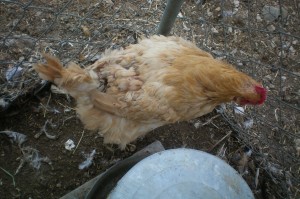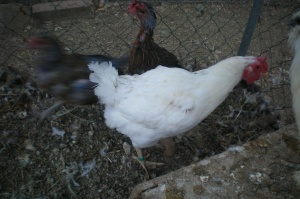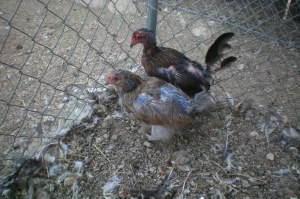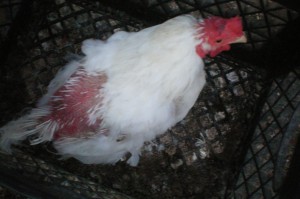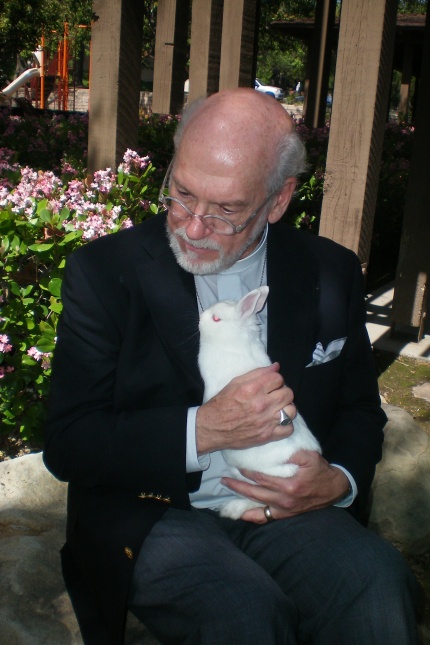It was a first birth for Claire and I was frankly surprised it went so rough. Her mom had always had an easy time getting her kids on the ground, and some of the time did it without any help. I was sure she would follow in her mother’s footsteps. This time I was wrong. It was Monday morning and I noticed that her udder was quickly bagging up (of course she was not going to do it over the weekend, when I had time off work- doe’s code of honor). She started to get “that look” in her eyes and I knew her time was drawing near. I called in to the office to let them know I would be late, and started my watch. By noon she was picking at her food and talking to her side- it should not be long now. By 2 pm she was down on her side pushing, but by 2:30 she was not making any progress. I got out the gloves and the lube. There was a tiny pair of feet in the birth canal but not a head to be felt. Not good. I let another ten minuets go by and still no progress. I have done this enough to know when it is time to call the vet. Dr. Bailey was not in the office but I did have his cell number. He was only a few minutes away and came right over. He could feel the feet as well, but not the head with them. He tried to turn the kid, and then only had the head, but no front feet.
There just did not seem to be a way to get this baby into the proper position. “Well” I said at last “Just bring the kid out head first.” Dr. Bailey always likes to have the feet as well, but decided to deliver the kid without then this time. After some pushing, and a few screams from the doe, a tiny doe kid was pulled into the world. Dr. Bailey was surprised to see she was still alive. He handed her off to me and reached back in for the next one. Again after much pushing and pulling, a tiny buck kid was retrieved, weak and sputtering, but alive. He weighed in at only 1 lb 6 oz, and she just under 2 pounds. I am not sure if it was the traumatic birth or just Claire’s take on being a new mom, but the doe did not seem to want to have anything to do with these newborns. As Dr Bailey looked down at the two tiny, struggling babes on the blanket, he looked at me and said that I now had my work cut out for me. I think it was his kind way of saying these kids really did not have much of a chance at this point. If I could get them past the first 48 hours they might have a chance.

Newborn Phoebe
For the rest of the afternoon, I milked out the colostrum from the VERY uncooperative mother, and fed the kids with an eyedropper. I followed the doe around with the babes, hoping she would bond with them. Not only did she not want them anywhere near her- she actually turned around and butted them away, hard!
By that evening the night air began to chill, and I had no choice but to go to “plan B”, and bring the poor little things into the house. I found a large cardboard box, lined it with a plastic trash bag, and covered the floor with newspapers. Next I put down a heating pad, and then some large towels. this would keep them snuggley and warm. Both were too weak to suck on a bottle, so I fed them every 4 hours with the eyedropper throughout the night.
By the next morning, the little doe was strong enough to stand a bit, and I once again took her out and tried to introduce her to her mom. This time Clair knocked her for six, so I took her right back into the house. I came to the sad reallity that I would now be raising my very first pair of orphan kids.
The first 3 days were very tedious, keeping up with the feedings every 4 hours around the clock. By day 4, the little doe was finally able to latch onto the nipple of the bottle, but the little buck kid continued to grow weak, and he left us that same afternoon. It was touch and go every day with the doe. She did not gain much weight, and chilled easily. She was not able to stand up very well, and seemed weak in her front legs. Sometimes she did not want to eat at all, and I had to revert back to the eyedropper. I bought some Pedilite to keep her hydrated, and put a few drops of Red Cell in her milk at each feeding. Still she struggled.
I remembered when one of our goats had been anemic the year before, and we had given her injections of B-12, so I began to give the little doe 1cc of the B-12 every 12 hours.
At 1 week of age, she seemed unable to walk altogether, and was still not gaining any weight. I would hold her in my lap and move her little legs for her, so her muscles would not atrophy. This went on all through the second week of her life, until I noticed she was sometimes able to stand for a few minuets. I began to get behind her and just scoot her along so she would have to take small steps. I slept on the couch with her curled up in my arms to keep warm.
By week 3 she was taking more steps on her own, but was all but lame in the right front leg. I began to feed her a few teaspoons of greek yogurt every day, and continued the B-12 shots. She began to walk a bit more. Then one day I found her in her box laying stiff on her side. It looked she had seizured. She was still alive, so I got her upright and got her moving again. At one month old, I gave her 1cc of CDT and prayed. She still weighed a good pound less then the set of twins that were born a week after her. Her right front leg still buckled out in front of her, causing a limp.
More shots, more bottles, more prayer – day after day. I never even did name her, for fear every day that she would not live. Then the day came at last when she took a turn for the better. Her legs became stronger, she started to walk with ease, and then she delighted me one day when she jumped up the porch steps. At 5 weeks I tapered the B-12 down to 1 cc every other day, and then tapered off of it. We named her Phoebe, and she is now doing quite well. She downs 4 cups of milk replacer everyday, has gained weight, grown, and has started to nibble at some hay.

Our healthy, happy girl.
Now, at 6 weeks old, we go in back and have “play dates” in the nursery pen with the other moms and babies. We then race each other back down the driveway and into the kitchen. I marvel at her sweet but spunky personaility and try not to think back on those hard days we had together. Each day now she is less and less dependent on me, and goes off to explore her world more and more without me, but that’s ok. That is as it should be. As much as I enjoy the special bond we share I will be glad for the day when she will be able to go out and join the tribe.
For now I will just enjoy the last few weeks of the bottles, and the cuddling, and the sweet goat murmurs she whispers in my ears.
All the worry has been worth it, and it reminds me that I am indeed a goatherd, and to always be humble before God’s creatures.
